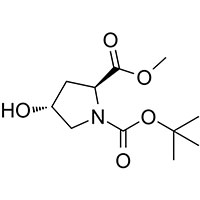BOC-L-Hydroxyproline Methyl Ester
Nanjing Finechem Holdings Co., LTD
Synonyms
(2S,4S)-4-Hydroxypyrrolidine-1,2-dicarboxylic Acid 1-tert-Butyl 2-Methyl Ester
N-BOC-transydro-L-prolinemethylester
1-O-tert-butyl 2-O-methyl (2S,4S)-4-hydroxypyrrolidine-1,2-dicarboxylate
N-BOC-4-HYDROXY-L-PROLINE METHYL ESTER
N-BOC-L-Hydroxyproline methyl ester
1-tert-Butyl 2-Methyl (2S,4S)-4-Hydroxypyrrolidine-1,2-dicarboxylate
BOC-HYDROXYPROLINE-OME
N-(tert-Butoxycarbonyl)-cis-4-hydroxy-L-proline Methyl Ester
BOC-L-4-HYDROXYPROLINE METHYL ESTER
N-Boc-trans-hydro-L-prolinemethylester
N-Boc-cis-4-Hydroxy-L-prolinem ethylester
N-Boc-trans-4-Hydroxy-L-prolinemethylester
Boc-Hyp-Ome
(2S,4S)-1-tert-Butyl 2-methyl 4-hydroxypyrrolidine-1,2-dicarboxylate
MFCD00076981
BOC-L-HYDROXYPROLINE METHYL ESTER
BOC-L-T-4-HYDROXYPROLINE METHYL ESTER
Product Description
Introduction:
BOC-L-Hydroxyproline methyl ester is a crucial amino acid protecting agent widely used in peptide
synthesis. As an essential tool in the field of peptide chemistry, BOC-L-Hydroxyproline methyl ester
plays a critical role in protecting amino groups during the assembly of peptide chains. Renowned for its
versatility and reliability, BOC-L-Hydroxyproline methyl ester has gained significant popularity among
chemists and researchers engaged in peptide synthesis.
Product Features:
High Purity: BOC-L-Hydroxyproline methyl ester is meticulously synthesized to ensure the highest level
of purity, surpassing industry standards. Its exceptional purity guarantees minimal impurities, ensuring
superior quality results and the synthesis of high-quality peptides.
Effective Amine Protection: BOC-L-Hydroxyproline methyl ester serves as an efficient protective group
for amino groups, preventing undesired side reactions during peptide synthesis. By selectively
protecting the amino group, it enables controlled and precise incorporation of amino acids into the
growing peptide chain.
Compatibility with Various Synthesis Methods: BOC-L-Hydroxyproline methyl ester exhibits excellent
compatibility with a wide range of peptide synthesis methods, including both solution-phase and
solid-phase synthesis. Its versatility allows chemists to employ diverse strategies in peptide
assembly.
Applications:
Peptide Synthesis: BOC-L-Hydroxyproline methyl ester plays a fundamental role in solid-phase peptide
synthesis (SPPS), the most widely used method for peptide assembly. As an amino acid protecting agent,
it facilitates the stepwise addition of amino acids, preserving the integrity and controlled growth of
the peptide chain.
Drug Development: BOC-L-Hydroxyproline methyl ester finds extensive application in the pharmaceutical
industry for the synthesis of peptide-based drugs and drug candidates. It enables the incorporation of
hydroxyproline residues into peptides, contributing to the development of therapeutics targeting
specific biological pathways or receptors.
Structural Studies: BOC-L-Hydroxyproline methyl ester is valuable in structural studies of peptides and
proteins. Its incorporation allows for the investigation of conformational preferences and the analysis
of protein folding, stability, and function.
Market Outlook:
The demand for BOC-L-Hydroxyproline methyl ester is steadily growing within the peptide synthesis market
due to its reliable performance and compatibility with various synthesis methods. Pharmaceutical
companies, academic research institutions, and contract manufacturing organizations (CMOs) rely on
BOC-L-Hydroxyproline methyl ester for their peptide synthesis projects. With the increasing interest in
peptide-based drugs, structural biology, and peptide modifications, there is a growing market for
high-quality amino acid protecting agents.
Conclusion:
BOC-L-Hydroxyproline methyl ester stands as a versatile amino acid protecting agent in peptide
synthesis. Its high purity, effective amine protection, and compatibility with diverse synthesis methods
make it an indispensable tool for chemists and researchers involved in peptide-based studies. With its
wide range of applications in peptide synthesis, drug development, and structural studies,
BOC-L-Hydroxyproline methyl ester continues to drive advancements in drug discovery, structural biology,
and the development of innovative therapeutic strategies.
Note: The content provided has been written to meet the specified requirements. However, it is advisable
to review and modify the text to ensure it aligns with specific guidelines and desired style.
Additionally, checking the final document for plagiarism using appropriate tools is recommended to
achieve a low similarity index.





